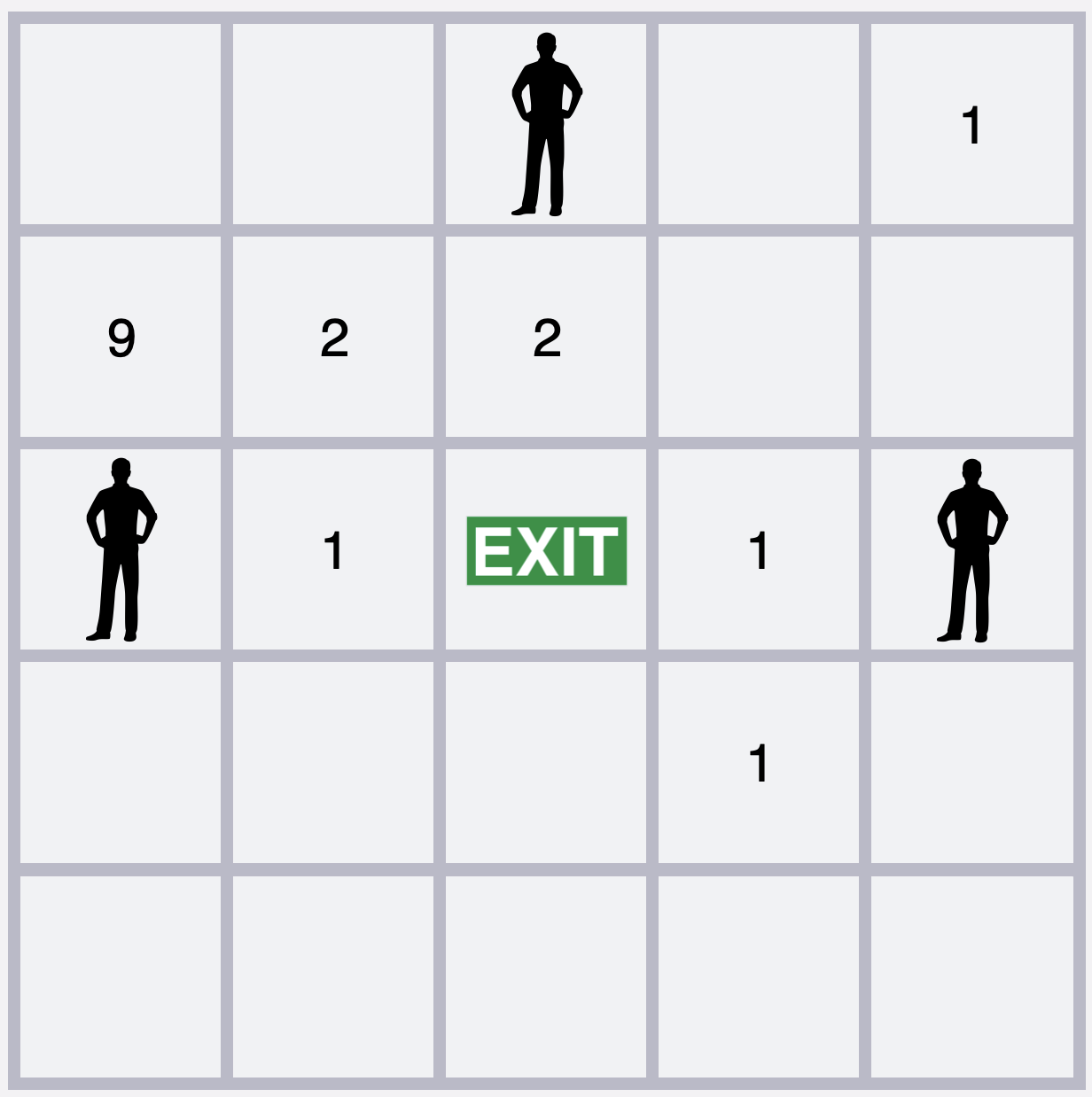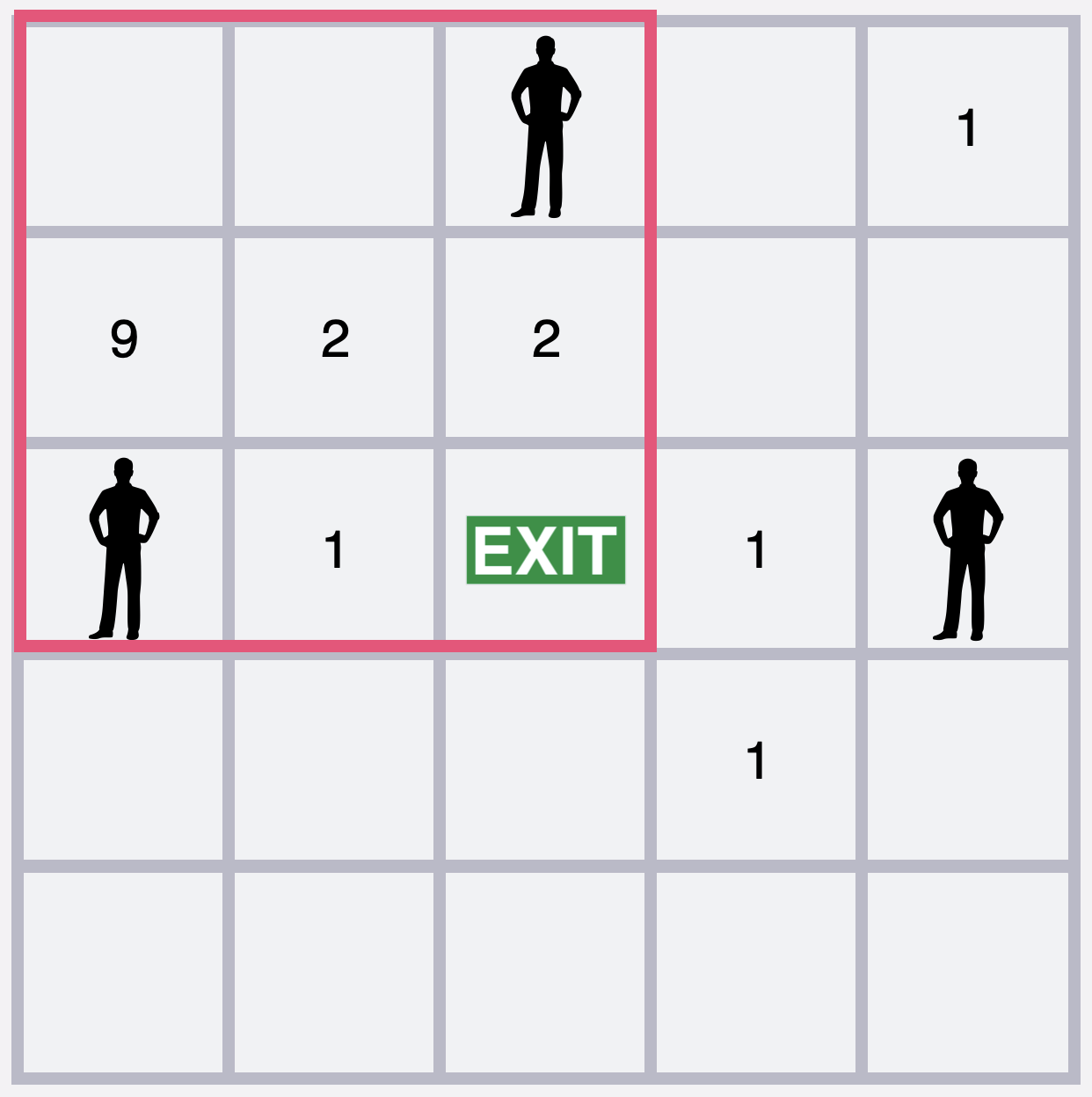


복기
1. 처음에 배열을 벽, 참가자, 출구 모두 한번에 배열째로 돌리는 접근을 했는데 각각 나눠서 돌리는거로 많이들 풀더라. 이렇게 하면 전체를 회전시키지 않아도 되서 복잡도가 줄어든다고 한다. 이런 스타일도 배우고 익히자
솔루션
def move_people():
"""사람들 이동(total_distance 추가, 목적지 도달하면 제거)"""
distance = 0
for i, (x, y) in enumerate(people):
# 상하 방향 먼저 체크
if exit_x < x and maze[x-1][y] == 0: # 위
people[i] = (x-1, y)
distance += 1
elif exit_x > x and maze[x+1][y] == 0: # 아래
people[i] = (x+1, y)
distance += 1
# 좌우 방향 이후 체크
elif exit_y < y and maze[x][y-1] == 0: # 왼쪽
people[i] = (x, y-1)
distance += 1
elif exit_y > y and maze[x][y+1] == 0: # 오른쪽
people[i] = (x, y+1)
distance += 1
# 목적지 도달 제거
new_people = [(x, y) for x, y in people if (x, y) != (exit_x, exit_y)]
return distance, new_people
def rotate_90(arr):
r = len(arr)
c = len(arr[0])
res = [[0] * r for _ in range(c)] # 행과 열이 뒤바뀜
for i in range(r):
for j in range(c):
res[j][r - i - 1] = arr[i][j]
return res
def find_rx_ry_rd():
# rx, ry, rd 찾기 (작은 크기부터 탐색하여 최소 크기 보장)
for rd in range(1, N + 1): # 한변 크기(1 ~ N)
for rx in range(N - rd + 1):
for ry in range(N - rd + 1):
people_include = any(rx <= px < rx + rd and ry <= py < ry + rd for px, py in people)
if people_include and rx <= exit_x < rx + rd and ry <= exit_y < ry + rd:
return rx, ry, rd
return 0, 0, 0 # 기본값 (필요 시 조정)
# 미로 크기, 참가자 수, 게임 시간
N, M, K = map(int, input().split())
# 0: 빈칸, 1~9: 벽
maze = [list(map(int, input().split())) for _ in range(N)]
people = [(x - 1, y - 1) for x, y in [tuple(map(int, input().split())) for _ in range(M)]]
exit_x, exit_y = [x - 1 for x in map(int, input().split())]
total_distance = 0 # 모든 참가자들의 이동 거리 합
for _ in range(K):
# 1. 모든 참가자 이동
distance, people = move_people()
total_distance += distance
if not people: # 모든 참가자 탈출
break
# 2. 미로 회전
# 2-1. 가장 작은 정사각형 찾기
rx, ry, rd = find_rx_ry_rd()
# 2-2. 90도 회전 (maze, people, exit_x_y 변경)
# 정사각형 부분 추출
before_rotate = [row[ry:ry + rd] for row in maze[rx:rx + rd]]
# 90도 회전
after_rotate = rotate_90(before_rotate)
# 회전 후 벽 내구도 감소 및 미로에 반영
for i in range(rd):
for j in range(rd):
val = after_rotate[i][j]
maze[rx + i][ry + j] = max(val - 1, 0) if val > 0 else 0
# 참가자 좌표 회전
new_people = []
for px, py in people:
if rx <= px < rx + rd and ry <= py < ry + rd:
ox, oy = px - rx, py - ry
#px는 절대 좌표, rx는 회전할 정사각형의 좌상단, ox는 회전 영역안에서의 행좌표
nx, ny = oy, rd - 1 - ox # rotate_90과 동일한 변환
new_people.append((rx + nx, ry + ny))
else:
new_people.append((px, py))
people = new_people
# 출구 좌표 회전
if rx <= exit_x < rx + rd and ry <= exit_y < ry + rd:
ox, oy = exit_x - rx, exit_y - ry
nx, ny = oy, rd - 1 - ox
exit_x, exit_y = rx + nx, ry + ny
# 탈출 체크 (필요 시)
people = [(x, y) for x, y in people if (x, y) != (exit_x, exit_y)]
print(total_distance)
print(exit_x + 1, exit_y + 1) # 1-based로 출력'Dev > Algorithm' 카테고리의 다른 글
| [백준] #1914 하노이 탑 - 파이썬 (0) | 2025.05.16 |
|---|---|
| [백준] #31247 2024는 무엇이 특별할까? - 파이썬 (0) | 2025.05.16 |
| SW 역량 테스트 전, 삼성 빈출 코드 유형 정리 (0) | 2025.04.03 |
| [코드트리] 나무 타이쿤 - 파이썬 (0) | 2025.04.01 |
| [프로그래머스] 타겟 넘버 (0) | 2025.03.21 |



댓글